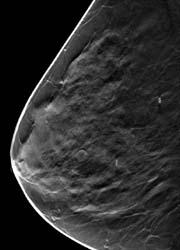
September 26, 2011 — Hoag Breast Care Center recently became the first breast care center in California and one of a handful in the United States offering 3-D digital breast tomosynthesis for breast cancer screenings. The technology promises to improve breast cancer detection, especially in young women and women with radiographically dense breast tissue.
Digital breast tomosynthesis (DBT) is a U.S. Food and Drug Administration (FDA)-approved 3-D imaging modality that can identify and characterize individual breast structures without the confusion of overlapping tissue. It is especially beneficial for women with dense breasts.
Dense breast tissue can obscure an underlying cancer, or conversely mimic a cancer when none exists. Approximately 15 to 20 percent of breast cancers cannot be detected using traditional 2-D mammography, especially in women with dense breast tissue.
"It's a major milestone to be the first breast center in California to provide patients with digital breast tomosynthesis," said Gary M. Levine, M.D., director of breast imaging at Hoag Breast Care Center. "At Hoag we have been involved with the development and testing of tomosynthesis since 2009. Recent reader studies have confirmed digital breast tomosynthesis to be superior to conventional mammography alone at finding early breast cancer. Tomosynthesis will allow us to discover more early stage breast cancers, and early detection translates to lives saved."
During a tomosynthesis exam, 15 digital "projection" images are captured as the system arcs over the breast during a short four-second scan. These images are then digitally reconstructed into a series of high-resolution one-millimeter slices that can be reviewed individually or played back in a cine loop.
"Tomosynthesis, by solving the issue of tissue superimposition, will not only allow us to detect breast cancer more reliably, it will also reduce the number of unnecessary call backs for additional testing," Levine said. "This will then address a frequent criticism of mammography by reducing anxiety and controlling costs."
A woman can learn if her breasts are dense by asking her physician or the radiologist who performs her mammogram. Breast density is not based on family history and cannot be determined by look and feel of the breast. Approximately 75 percent of women in their forties have dense breasts, and this percentage typically decreases with age; 54 percent of women in their fifties and 42 percent of women in their sixties having dense breasts. Approximately 40 to 50 percent of women Hoag screens annually have extremely dense breast tissue, particularly younger women ages 40-49.
Regardless of dense breast tissue, mammograms and self breast awareness play a crucial role in early detection. Breast cancer is the second leading cause of cancer death among women, exceeded only by lung cancer. Statistics indicate one in eight women will develop breast cancer sometime in her lifetime.
The stage at which breast cancer is detected influences a woman's chance of survival. If found and treated early, while still localized in the breast, the ten-year survival rate for breast cancer is greater than 90 percent.
Hoag offers digital breast tomosynthesis to Orange County women due to a generous grant from Circle 1000, a group of women that have raised funds for Hoag Family Cancer Institute since 1987. In the near future, Hoag will be extending this technology to Irvine as well.
For more information: hoag.porternovelli.com/


 December 08, 2025
December 08, 2025 









